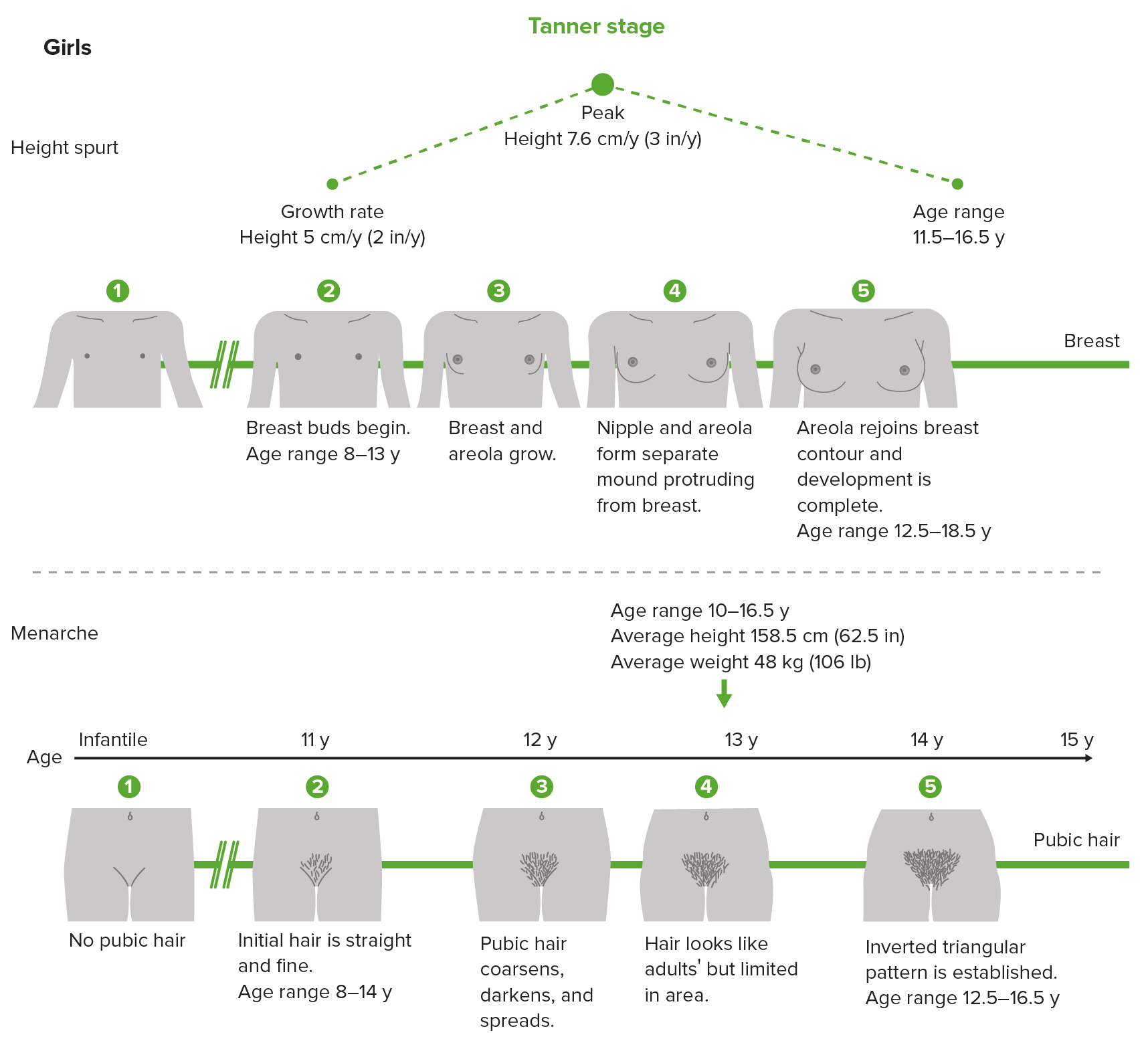Playlist
Show Playlist
Hide Playlist
Puberty
-
Slides Normal Puberty.pdf
-
Download Lecture Overview
00:00 Let’s talk a little bit more about puberty. So before we discuss puberty, let’s discuss the hypothalamic-pituitary axis. In this case, we’re referring to the HPO or the hypothalamic-pituitary-ovarian axis. First, there is input from the environment into that axis which goes into the central nervous system which then feeds into the hypothalamus which via GnRH or gonadotropin releasing hormone feeds into the anterior pituitary. 00:29 The anterior pituitary produces FSH and LH, FSH standing for follicle stimulating hormone and LH standing for luteinizing hormone which then feeds into the ovary. The ovary then responds with sex steroid hormone formation which feeds into the uterus. The estrogen causes the endometrial lining to be formed. Then the estrogen from the ovary feeds back into the hypothalamus as well as progesterone feeding back into the hypothalamus and the anterior pituitary. 01:02 The uterus then, if it’s intact, will cause a menstrual cycle to occur. This entire system has to be intact for normal pubertal development to occur. It all culminates in the menses. 01:17 So remember, you should remember that the menses is a vital sign in a young girl. 01:21 If one of these systems are not functioning, she will not menstruate normally. 01:27 Let’s talk about now pubertal milestones. So, let’s talk about thelarche or the development of breasts. 01:35 This is very high yield because there are lots of questions that can pertain to this subject. 01:41 When you’re about 10 ½ years old, you start to make breast buds. Oftentimes, this is confused with some type of pathology but they are hard upon examination. Then you might start to have pubic hair. 01:55 Then you have maximal growth around 11 years old. Then you have menarche which is the onset of menses. 02:03 Finally, you have adult pubic hair close to 14 years of age. Now, these ages are based on healthy children. 02:11 However, children who have other medical problems may not meet these milestones. 02:17 Again finally, you have adult breast contour by 14 ½, close to 15 years old. 02:23 Now that we’ve discussed some normal milestones, let’s talk about the first signs of puberty. 02:30 First, you have acceleration of growth followed by thelarche or breast budding, pubarche (appearance of pubic hair), and menarche (menses). It typically happens in that order. 02:43 Menarche should never be the first sign. That should alert the clinician that something is amiss. 02:50 Let’s just now review the different stages of thelarche. This is a system called Tanner staging, Tanner stage 1, 2, 3, 4, and 5. There is no zero. With Tanner stage 1, you’ll see here that the Tanner stage 1 patient is prepubertal. There is no breast development. 03:08 At Tanner stage 2, there is a breast bud which again feels hard upon palpation and can often be confused with pathology. Tanner stage 3, you see that there is a breast elevation. 03:22 Tanner stage 4, you see that there is areolar mound while Tanner stage 5 is a normal adult contour. 03:29 Again, review this before your test. This may be a question and this could be very high yield. 03:36 First signs of puberty, let’s talk about pubarche now. Again, we use Tanner staging here. 03:41 Tanner stage 1 is prepubertal while Tanner stage 2 is presexual hair. You may have some hair. 03:48 But in Tanner stage 3, you develop even more pubertal hair. In Tanner stage 4, here you’ll see a mid-escutcheon. That develops into a Tanner stage 5 which is adult female escutcheon. 04:02 On average, menarche occurs 2.6 years after the onset of puberty. Again, you may start to see some signs. 04:11 Not all girls will achieve Tanner staging at the very same time. So, let’s review. 04:18 Remember, female sexual determination is not a default. It’s actually genetically determined and upregulation of certain genes have to occur. Remember that the paramesonephric development happens in the absence of AMH or anti-Müllerian hormone which is made by the Sertoli cells in the male system. Germ cells migrate to the gonadal ridge and invade the gonads taking cues from somatic cells. The impetus for puberty is not known. 04:49 Thank you for listening and good luck on your test.
About the Lecture
The lecture Puberty by Lynae Brayboy, MD is from the course Normal Puberty and Disorders of Sexual Development.
Included Quiz Questions
Which of the following usually occurs at 10.5 years of age in a normal girl?
- Thelarche
- Menarche
- Pubarche
- Growth of pubic hair
- Attaining maximal growth
Which of the following is the correct sequence of pubertal development in girls?
- Breast bud formation; Onset of pubic hair; Maximal growth; Menarche
- Onset of pubic hair; Breast bud formation; Maximal growth; Menarche
- Onset of pubic hair; Maximal growth; Breast bud formation; Menarche
- Breast bud formation; Menarche; Onset of pubic hair; Maximal growth
- Breast bud formation; Onset of pubic hair; Menarche; Maximal growth
At what age does menarche usually occur?
- 12.4 years
- 10.5 years
- 11 years
- 11.4 years
- 13.7 years
Which of the following correspond to the formation of a small, firm-to-hard breast bud according to Tanner staging?
- Tanner stage 2
- Tanner stage 1
- Tanner stage 4
- Tanner stage 5
- Tanner stage 3
Which of the following best describes the Tanner stage 4 for girls?
- Areolar mound with mid escutcheon
- Prepubertal breast and pubic hair
- Breast bud and pre-sexual hair
- Elevation of the breast bud and sexual hair
- Adult contour of breast and escutcheon
When does menarche occur relative to the onset of puberty in a normal girl?
- On average 2.6 years after the onset of puberty
- On average 1.6 years after the onset of puberty
- On average 0.5 year after the onset of puberty
- On average 2 years after the onset of puberty
- On average 1 year after the onset of puberty
Customer reviews
5,0 of 5 stars
| 5 Stars |
|
5 |
| 4 Stars |
|
0 |
| 3 Stars |
|
0 |
| 2 Stars |
|
0 |
| 1 Star |
|
0 |




